Stadium completion on track for football opener
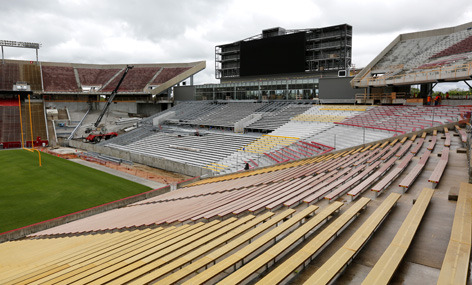
An interior view of the bowled-in south end zone at Jack Trice Stadium. Work is on schedule to wrap up by Sept. 5. Photos by Christopher Gannon.
Work on the south end zone addition to Jack Trice Stadium is on schedule to be completed in time for the Cyclone football squad's first home game on Saturday, Sept. 5.
"We're now to the point that – unless something out of our control comes up – we feel comfortable with the remaining construction schedule," said Chris Jorgensen, senior associate athletics.
The club facility is enclosed, most of the interior framing is complete and some finishing work is underway. Jorgensen said getting the first-floor kitchen completed and operable is "probably our biggest challenge" this summer. The new kitchen will serve not only Sukup End Zone Club members, but also guests in the stadium's other suite and club sections.
Crews have begun installing seats on both the upper and lower levels of the south corners. Paving was scheduled to begin this week on the exterior south plaza and sidewalk ramps from the plaza up to the east and west concourses will be poured in June.
Four restroom buildings are being added on the stadium's concourse level. Including interior restrooms in the club facility, Jorgensen said the stadium will have an additional 200 toilet or urinal fixtures.
Club seats still are available
Jorgensen said fans have purchased more than 2,000 of the available 3,000 season tickets in the Sukup End Zone Club section, "and we're very excited about that start."
The expansion "bowls in" the south end of the stadium, creates a new south entrance and continuous permanent seating on the lower level, and adds upper-level seating in the south corners. It replaces the former south bleachers and two hillside areas with 13,000 permanent seats, which includes the end zone club seats. End zone club ticket holders have access to a two-story, indoor club facility, the top level of which will overlook the field.
The project also includes a new south video board and an electronic ribbon board around the stadium.
The UNI Panthers come to town on Sept. 5, with the Iowa Hawkeyes visiting a week later. Additionally, the Cyclones host four Big 12 Conference opponents – Kansas, Texas Christian, Texas and Oklahoma State – during the 2015 season.
Next phase is still a concept
Jorgensen said that a companion entry way project to replace what now is mostly parking lots separating the stadium and Reiman Gardens, still is in the design phase. He said south stadium lots will be available for fan parking this season. The two phases, totaling $60 million, will be covered by a February $32 million bond sale and $28 million in athletics department private gifts and annual revenues.
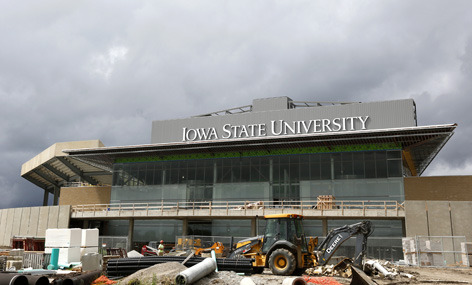
The south exterior of the club facility.
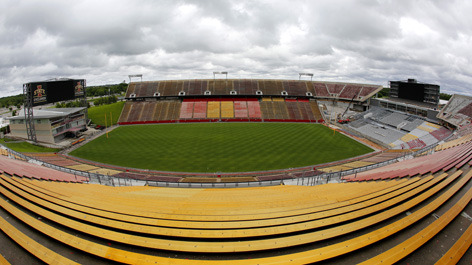
Jack Trice Stadium, shot from the west upper level with a fisheye lens.
Freshman orientation runs June 1-July 1
Up to 5,800 admitted freshmen will visit campus for orientation in June. Accompanying them will be an estimated 8,500 family members. The first of 20 two-day sessions begins Monday, June 1; the final session concludes on Wednesday, July 1. On either end (May 29 and July 2) is a one-day orientation session for transfer students.
Each freshman orientation session accommodates up to 300 total would-be students and their families from three of Iowa State's undergraduate colleges. The College of Engineering will participate in 17 of the 20 sessions; the College of Design will get its orienteering tasks accomplished in five sessions.
While orientation isn't mandatory, students participate in large numbers. New student programs director Liz Kurt said that a year ago, between June orientation and a "just in time" August orientation, 98 percent of Iowa State's fall 2014 freshman class participated. For some, it's a chance to affirm a decision made months earlier. Others are still shopping.
"About 35 percent of our orientation students last summer didn't attend a formal campus visit previously," Kurt noted. "We have students using orientation to make their decision about whether they're coming to Iowa State. Families make their summer vacations out of a series of orientation events."
Orientation students travel from as far as California and Florida, Kurt said.
What they'll accomplish
Orientation students will get an introduction to their home colleges, meet their academic advisers and register for fall classes. They'll get their ISU Cards, Net IDs and email accounts; learn how their UBill works; and get lots of advice from current ISU students on transitioning to college life. Numerous tours are available to them, including campus, residence halls, sorority or fraternity houses and Parks Library.
Where they'll be
Orientation families will park in the lot east of the Maple Willow Larch residence complex and check in at the Hixson-Lied Student Success Center. Those who are staying overnight on campus will stay in Maple Hall. The colleges will use auditoriums in Hoover, Design, Troxel, LeBaron, Gerdin and Kildee halls for their large group afternoon events. Other locations that will receive heavy use include the Curtiss auditorium (financial aid and university billing sessions), Durham Center (Net-ID and email registration), Beardshear (ISU Card processing and financial aid appointments) and the Memorial Union (resource fair, day sessions for family members, housing tours, meals, shopping and evening sessions). Visitors will take their evening meal in the Union Drive Community Center and breakfast in either the MWL Commons or the Memorial Union.
Getting around
Road and sidewalk closures on Beach Avenue and Wallace Road will alter how orientations guests navigate campus this summer. CyRide's orange (campus circular) route detours east on Lincoln Way from Beach, heads north on University Boulevard and south on Wallace Road. Kurt said she will staff a crossing guard at Lincoln Way/Beach during morning hours to help guests make the counter-intuitive south crossing of Lincoln Way to catch a bus to central campus. Pedestrians will be advised to move toward central campus from the Hixson-Lied center through the Richardson Court corridor.
Orientation students will carry red string bags; family members will have oatmeal-colored canvas bags bearing the university nameplate.
"We're serving 35 percent more undergraduate students than we were five years ago," Kurt said. "We hope the campus community will be courteous, kind and helpful to them."
Biosciences proposal goes to regents next week
Iowa State leaders hope to receive state Board of Regents approval for two biosciences projects -- an addition to Bessey Hall and a new teaching/research building – when the board meets June 4 in Ames. The meeting, scheduled for 230 Scheman Building, begins with committee meetings from 9 a.m. to noon. The full board convenes at 1 p.m., and its agenda is online. There will be live audio streaming of public portions of the meeting.
A proposed four-story addition to the east side of Bessey Hall would cost $28 million and be funded by state appropriations. It would house undergraduate teaching labs and research labs for two departments (ecology, evolution and organismal biology, and genetics, development and cell biology), two general university classrooms and support space. The fourth floor would remain undeveloped for now. The proposal includes modernizing about 8,000 square feet of space in Bessey.
The proposed Advanced Teaching and Research Building, a five-story building with roof greenhouse, would be located on the northwest corner of the Stange Road-Pammel Drive intersection. The cost, $52 million, would be covered by state appropriations ($22 million), university funds ($20 million) and private gifts ($10 million). It would house the plant pathology and microbiology department and portions of two others: the entomology department and the genetics, development and cell biology department. It would include space for research and related support, faculty and graduate student offices, teaching labs, formal and informal collaboration, department administration, a plant diagnostic clinic and a general university lecture hall. The fifth floor would be undeveloped for now. The proposal includes $500,000 to demolish Industrial Education II, built in 1926, which currently stands on the site.
Settlement for retirement accounts
The board will be asked to approve a proposal to distribute $2.5 million among regent employees' TIAA-CREF accounts from a 20-state settlement with Standard and Poor's Rating Services. The lawsuit focused on misleading investment advice provided by S&P leading up to the 2008 financial crisis. The state of Iowa's share of the $1.375 billion settlement is $21.5 million. Of that, $10 million will be added to the state's IPERS fund and $2.5 million will be directed to individual TIAA-CREF accounts.
Associate vice president for business and finance Pam Cain said the distribution works out to $42.87 for each of the 58,317 eligible participants. The regent schools agreed to distribute by a simple head count rather than try to determine proportional amounts based on the size or movement of individual accounts. Cain said eligibility was granted to TIAA-CREF participant employees who:
- Were employed in the regents system for any duration from September 2004 to October 2007
- Still have an active TIAA-CREF account (haven't closed them since October 2007)
If the board approves the distribution proposal, Cain said the Iowa attorney general would send a check directly to TIAA-CREF for distribution to employee accounts. The universities will not receive the money.
Presentations
Board members will hear several Iowa State presentations on Thursday. Professor of ecology, evolution and organismal biology Lynn Clark and senior Laura Ekl will highlight the interdepartmental undergraduate program in biological/premedical illustration, a shared program of the colleges of Design and Liberal Arts and Sciences. This presentation will begin at approximately 9 a.m. to the board's Education and Student Affairs Committee.
Three presentations are scheduled before the full board on Thursday afternoon.
- Graduate College dean David Holger and kinesiology doctoral student Zachary Zenko will provide an update on programs and efficiency initiatives in the Graduate College.
- Brent Shanks, Distinguished Professor of chemical and biological engineering and director of the Center for Biorenewable Chemicals, will provide an overview of the center's partnerships, research and relevance to the state economy.
- Interim chief information officer Jim Kurtenbach, with his peers from Iowa and Northern Iowa, will discuss IT security issues, including vulnerability, threats and countermeasures.
Evaluations
In closed sessions Thursday afternoon and continuing Friday morning, the board will complete its annual performance evaluations of the three university presidents, the superintendent of the Iowa School for the Deaf, Council Bluffs; and the Iowa Braille and Sight Saving School, Vinton; and board executive director Robert Donley.
ISU accreditation reports
To expedite its Thursday meeting, the board's Education and Student Affairs Committee also will meet on Wednesday (4-6 p.m., 275 Scheman) to review four ISU accreditation reports:
- Landscape architecture programs
- College of Business
- Accounting programs
- Educator preparation programs
More ISU items
In other Iowa State-related business:
- The university will seek permission to purchase 29 acres of land along State Avenue in west Ames from the housing developer Breckenridge Group, Austin, Texas, for $1.31 million. The land is adjacent to an ISU teaching/research plot at the intersection of State Avenue and Mortensen Road. The university sold this parcel (and land to the west) in 2000 to the Ames school district for a new middle school and community recreation facilities. The school was built, but the recreation facilities were not, and in 2013 the school district sold the land to Breckenridge to be part of a high-density student housing development that created much controversy. Breckenridge asked the university in April if it would be willing to purchase the plot at appraised value.
- Board staff member Diana Gonzalez will demonstrate to board members the three universities' new joint application web portal, one of the outcomes of the board's TIER (Transparent, Inclusive Efficiency Review) process. The website allows individuals to apply to one or more of the regent universities in a single process.
- The university will seek permission to sign a 10-year lease (2015-25) with CB Solar Inc., Des Moines, for a 12,000-square-foot parcel near the east campus wind turbine on which to install a gifted solar system. Iowa State would receive any solar power (electricity) generated at no cost and provide annual generated electricity records to the company. The facility would be available for education and research purposes. This fits in with Iowa State's efforts to diversify its energy sources.
Looking good, LaVerne
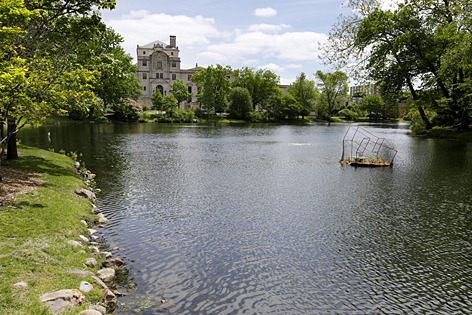
Mother Nature pitched in to (temporarily) help clear up the algae bloom in Lake LaVerne. Cooler temperatures and an influx of fresh water from a rainy May gave the lake an aesthetic boost. Facilities planning and management crews and student volunteers worked this spring to remove an unusually early filamentous algae bloom sparked by warm, dry weather. The algae will reappear once temperatures rise and rainfall decreases.
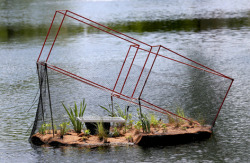
Vegetated floating island on Lake LaVerne. Photos by Christopher Gannon.
A research team launched its first of three floating islands, pictured right, on the lake in May. The vegetated structures -- designed by faculty and graduate students -- pull contaminants and pollutants from the water and provide habitat for birds, insects and aquatic wildlife, whatever the weather.
The interdisciplinary pilot project is a partnership with the Story Soil and Water Conservation District, and received a grant from the Iowa Watershed Improvement Review Board. The remaining two floating islands should be launched this week.
Textbook reorganization at bookstore: subtle but significant
A subtle change this spring in the University Book Store's textbook department is expected to have a noticeable effect on both customer service and staff efficiency. In April, book division manager Heather Dean and her staff reorganized all textbooks by author's last name, discarding the decades-old system of grouping texts by academic discipline and course number.
Hey, was that a yawn?
Alphabetical by author is the new normal among large university bookstores, Dean said. Universities like Arizona and Missouri made the switch several years ago "and now wonder why they didn't do it years earlier," she said.
"It all comes down to customer service," Dean said. The new organization is more intuitive and less confusing for students, she said, and cuts down on bottlenecks in the textbook area, reducing the time needed to locate and purchase books. The rollout for the first summer session went smoothly, she added.
A key strength of the alphabetical system is that a textbook, no matter how many courses or departments use it, is stocked in one location. Previously, bookstore staff spent a lot of time searching for book copies for customers when a title needed to be stocked in three or four -- or more -- department sections. That efficiency has opened up nearly 500 linear feet of shelf space within the textbook area that Dean can use to keep overstock inventory nearby.
"The less time my staff spends on processes or on moving books, the more time they can be out here helping customers," Dean said.
Booklists
Students' booklists now are arranged by author's last name, but the option of searching by course still remains. Faculty who occasionally liked to peruse their department's textbook area to see what texts their colleagues are using, aren't out of luck. Dean said her staff can create a textbook list by discipline when someone requests it.
Questions about the new organization system may be directed to Dean, 294-0237, or to store director Rita Phillips, 294-0231.
Dean said the bookstore communicated the change to students and employees the week of May 11 through emails, social media and store signage. She said the same will occur around Aug. 1 in anticipation of fall semester.
Up next
The next improvement to the textbook department will be digital screen shelf tags (think Kohl's department store), which will better accommodate the bookstore's competitive, dynamic pricing system as the market shifts. Look for the new shelf tags for either the fall or spring semester.
Student health director search is underway
A university search committee is looking for the next director of the Thielen Student Health Center. New York City based Keeling and Associates is helping with the national search.
The position was posted in April and applications are due May 30. A hiring announcement is expected by Aug. 1, with a start date prior to January 2016. The director oversees all student health care operations, including primary health care, mental health care, laboratory and radiology services, physical therapy and an in-house pharmacy.
Martino Harmon, associate vice president for student affairs, is serving as interim director. Michelle Hendricks retired from Iowa State in September 2014.
Search committee
- David Biedenbach, assistant vice president, president's office
- Pam Elliott Cain, associate vice president, business and finance
- Martino Harmon, committee chair, associate vice president, student affairs
- David Holger, associate provost
- Laura Knowles, nursing supervisor, student health center
- Dabney Larson-Hargrafen, physical therapist, student health center
- Marty Martinez, psychologist, student counseling
- Breanna Meier, senior, kinesiology and health
- Carver Nebbe, MD psychiatrist, student health center
- Rose Wilbanks, committee support, administrative specialist, student affairs
